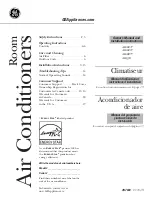
31
Unit maintenance
SPLIT RACK AIR CONDITIONER USER MANUAL
UM.ICUBE2.0-SRAC.SG.0822 August 2022 www.eaton.com
4.2 Simple fault handling
If there is an abnormal phenomenon in the operation of the unit, the cause of the fault must be found out
immediately, the fault must be eliminated immediately, and it can not be used until it is repaired. Do not ignore
the fault and continue to use. This may cause unpredictable damages.
ote:
N
the power supply must be cut off before any operation is carried out on the unit.
Fault phenomenon
Possible causes
Exclusion methods and countermeasures
No cooling
Indoor fan and compressor are not
working.
●
Power failure
●
Confirm the power supply voltage and wiring of the unit
●
Fan report fault
●
Confirm the connection of the motor, whether it is blocked
and the parameters.
●
The power supply voltage is too low.
●
Restore normal power supply voltage
●
Electrical connection loosened
●
Tighten the joint
●
The connection is incorrect and the terminal is
loosened.
●
Check the wiring and tighten it.
The indoor fan works but the
compressor does not turn.
●
Internal motherboard communication fault C3
●
Confirm the wiring of indoor and outdoor units
●
Compressor start failure
●
Confirm the wiring and communication of indoor and
outdoor units
●
Compressor start failure protection L1
●
Confirm that the condensation pressure is normal
●
Confirm that the line globe valve is open
●
The temperature setting is too high when
cooling.
●
Lower the temperature set point
●
Built-in protection action of compressor motor
●
Check wiring and compressor winding resistance
The indoor fan does not turn.
●
Action for overcurrent relay of indoor fan
●
Check the cause of overcurrent or contact maintenance
personnel
●
Indoor fan failure
●
Replace the fan or contact the maintenance personnel
Frequent start and stop of units
The compressor started but soon
stopped because of thermal
protection.
●
Too much or too little refrigerant
●
Leak detection, charge according to the correct refrigerant
charge
●
There is air or non-condensable gas in the
refrigeration circuit
●
Re-vacuum and charge refrigerant
●
Compressor failure
●
Find out the cause and replace the compressor
●
The voltage is too high or too low
●
Find out the cause and stabilize the power supply voltage
●
The airflow of indoor or outdoor units is not
smooth.
●
Clean the coil and filter regularly and check whether the
motor is running properly.
Compressor or refrigeration system is abnormal
High discharge pressure
●
Dirty plugging of condenser
●
Clean condenser
●
Condensation equipment does not operate
●
Check the operation procedure, check the condensing fan
●
Excessive refrigerant charge
●
Check whether the degree of supercooling is too high.
Low discharge pressure
●
Refrigerant leakage
●
Leak detection and maintenance and refrigerant addition
●
Speed regulation of outdoor fan
●
If defects are found, replace the outdoor unit or contact the
maintenance personnel
There is no change in
suction and discharge pressure
after start-up.
●
The outdoor compressor did not start.
●
Check if there is a communication failure in the system.
●
Air filter clogged
●
Replace the filter
Low suction pressure
●
Leakage or insufficient charge
●
Leak detection, replenishment of refrigerant
●
There is a blockage in the air inlet and outlet.
●
Removal of blockage
●
Condensation pressure is too low
●
Check for condenser failure
Compressor noise is too loud
●
Bearing wear caused by loss of lubricating oil
●
Add lubricating oil
●
Compressor or pipeline fixed loose
●
Tighten the clamp
Compressor running overheating
●
The compression ratio is too high
●
Check the settings of high and low voltage sensors
●
The suction temperature is too high.
●
Check to see if the condenser is clogged
●
Check that all evaporators and condenser fans are working
properly
●
Check whether the expansion valve is normal or add the
right amount of refrigerant
















































